Clinical Microbiology Market Size, Share & Trends by Application (Pharma, Food, Clinical,Manufacturing, Environment), Disease (Respiratory Disease, Blood Stream, GIT, UTI), Product (Instrument, Analyzer, Reagent), End User, and Region - Global Forecast to 2029
Clinical Microbiology Market Size, Share & Trends
The size of global clinical microbiology market in terms of revenue was estimated to be worth $5.0 billion in 2024 and is poised to reach $6.9 billion by 2029, growing at a CAGR of 6.5% from 2024 to 2029. The comprehensive research encompasses an exhaustive examination of industry trends, meticulous pricing analysis, patent scrutiny, insights derived from conferences and webinars, identification of key stakeholders, and a nuanced understanding of market purchasing dynamics.
The clinical microbiology market is driven by several key factors. Technological advancements have led to the development of new and improved microbial identification and antibiotic susceptibility testing techniques. The rising incidence of infectious diseases and pandemic outbreaks, such as COVID-19, have increased the demand for clinical microbiology testing. Increased funding and public-private partnerships in the healthcare sector have also contributed to market growth. There is a rising demand for rapid diagnostic tests, leading to increased R&D activities for the development of novel automated culture media and equipment. The use of clinical microbiology in biotechnology industries is also increasing. Lastly, the increased awareness of Healthcare-Associated Infections (HAIs) has led to a greater emphasis on infection control, driving the demand for clinical microbiology testing. These factors collectively contribute to the growth of the clinical microbiology market.
Clinical Microbiology Market Trends
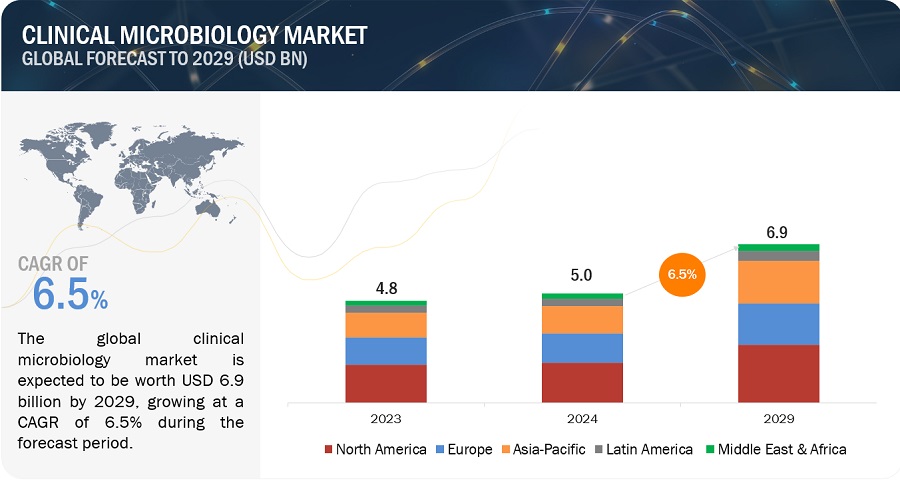
To know about the assumptions considered for the study, Request for Free Sample Report
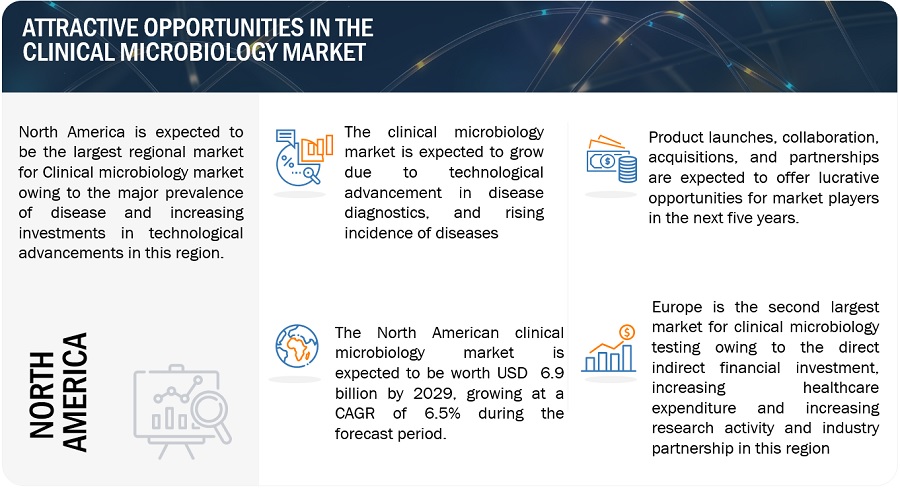
Clinical Microbiology Market Dynamics
Driver: Advancements in Technology for Disease Diagnostics
The field of disease diagnostics is rapidly evolving due to technological advancements, with emerging molecular diagnostic techniques gaining traction for early disease detection and effective treatment of pathogen-related illnesses. Cutting-edge molecular diagnostic methods offer several technological advantages over traditional laboratory techniques. These benefits include quicker turnaround times, higher sample processing capacities, the ability to perform multiplex reactions, enhanced specificity, improved accuracy, and heightened device sensitivity.
Technologies such as Next-Generation Sequencing (NGS), real-time Polymerase Chain Reaction (PCR), molecular cartridges, and PCR coupled with mass spectrometry are increasingly valued for their ability to identify and characterize pathogens and analyze multiple samples simultaneously. Consequently, these technologies are gaining popularity and seeing increased adoption among key users, including healthcare providers (such as hospitals and clinical centers specializing in microbiology), research laboratories, and pharmaceutical and biotechnology firms. The development and market availability of pathogen-specific reagents and diagnostic kits have improved sample utilization and facilitated the adoption of standardized clinical protocols for specific disease diagnosis. To adapt to evolving end-user preferences, leading product manufacturers are concentrating on creating and introducing innovative, technologically advanced molecular diagnostic products specifically designed for diagnosing infectious diseases.
Restraint: Inadequate Reimbursement Policies for Microbiology Testing
In several countries like India, China, and various emerging nations in the Middle East and Africa, clinical microbiology testing procedures face limited reimbursement, despite the substantial patient populations in need. This financial constraint significantly impacts patient and healthcare professional preferences towards clinical microbiology products. The restricted reimbursement policies directly hinder the adoption of higher-priced clinical microbiology products, thus impeding market growth in this sector.
Reimbursement for laboratory tests in hospital settings typically occurs through diagnosis-related group payments for in-patients. However, outpatient laboratory test reimbursements are managed locally, leading to considerable regional variation due to the absence of national standardization.
In the United States, microbial test adoption faces additional challenges, including limited coverage for operational costs associated with these procedures, constraints on research use only (RUO) diagnostic products, and delays in incorporating newly developed microbial test procedures into Current Procedural Terminology (CPT) codes for medical reimbursements. These factors collectively restrict the widespread adoption of microbial testing in clinical settings in the US.
Opportunity: Enhancing Healthcare Infrastructure in Emerging Countries
Emerging markets present substantial growth prospects for manufacturers and distributors of clinical microbiology products, driven by several factors. The rising frequency of infectious diseases like tuberculosis , HIV, , influenza, and malaria, along with increased research and development efforts to develop innovative genomic techniques for more efficient disease diagnosis in developing nations, underscores the potential growth in these regions.
Moreover, the expansion of healthcare infrastructure, growing healthcare expenditure, and the increased availability and affordability of low-cost clinical microbiology products contribute to the growth trajectory of these markets. Government initiatives in emerging markets, particularly in countries like China and India, are aimed at bolstering and expanding healthcare infrastructure to meet the evolving healthcare needs of their populations. This concerted effort creates a favorable environment for the adoption and utilization of clinical microbiology solutions, opening up new avenues for market expansion and development in these regions.
Challenge: Operational Hurdles in Diagnostic Testing
The use of diagnostic microbiology tests involves a wide range of patient samples, including semen, saliva, tissue, blood, and urine. Despite the diverse nature of these tests, automated instruments for directly diagnosing common pathogens like Plasmodium, Staphylococcus, and E. coli remain underutilized. Clinical laboratories face significant operational barriers related to sample handling and transportation, crucial for providing accurate diagnostic results in a timely manner. A key challenge is ensuring optimal conditions for sample collection and transportation. Laboratories must adhere to strict logistics protocols, including timely sample collection, efficient transportation, and safe standardized processing. For instance, preanalytical sample processing requires specific temperature control during procurement and transportation. Furthermore, laboratories must validate distinct preanalytical and analytical procedures tailored to each sample type to ensure accurate and optimal diagnostic outcomes.
Navigating these operational challenges poses a significant hurdle for clinical laboratories, impacting their ability to deliver reliable and efficient diagnostic services to patients. Addressing these complexities requires robust logistical support and adherence to stringent procedural standards to maintain the integrity and accuracy of diagnostic testing processes. Methods remain time-consuming, especially given the tight timelines typically faced by bioanalytical departments.
Clinical Microbiology Industry Ecosystem
In the clinical microbiology market, ecosystem analysis elucidates the intricate web of interdependencies among its various components. At the forefront, technology serves as the cornerstone, facilitating precise pathogen detection through state-of-the-art diagnostic tools. These tools are indispensable for end users, including hospitals and clinics, who rely on them extensively to make critical patient care decisions. Within this ecosystem, a spectrum of players, ranging from established industry leaders to emerging entities, contribute to the market's vitality by offering a diverse array of diagnostic instruments, reagents, and complementary technologies. Reagents, pivotal for sample analysis, represent a crucial link in the diagnostic chain. Additionally, peripheral technologies, exemplified by data management systems, play a pivotal role in optimizing laboratory workflows, thereby enhancing efficiency and throughput. Presented below is a concise tabular representation of select companies and their respective roles within this ecosystem:
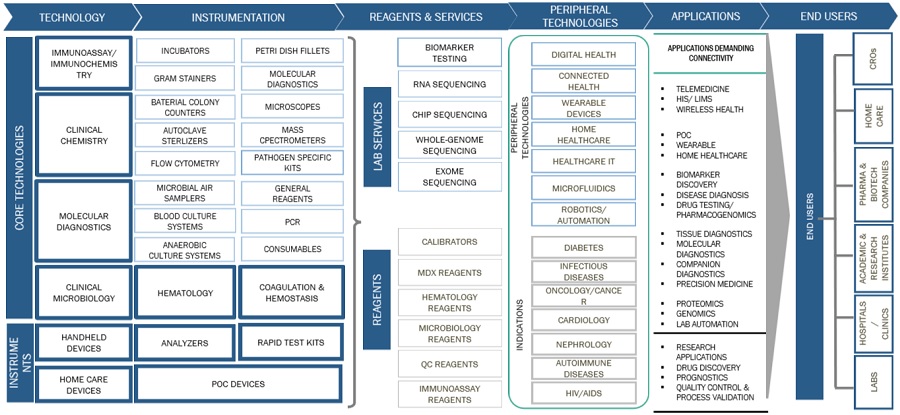
Source: Secondary Literature, Interviews with Experts, and MarketsandMarkets Analysis
The Instruments segment of the clinical microbiology industry, is projected to grow at a CAGR of 5.6% between 2024 and 2029.
In the clinical microbiology industry, the instruments segment is expected to hold the largest market share during the forecast period. This dominance is driven by factors such as widespread adoption of conventional laboratory instruments by researchers and academia, technological advancements in molecular techniques and proteomics (such as microfluidics integrated with PCR and nanotechnology with qPCR), and the increasing trend of laboratory automation in clinical settings.
Pharmaceutical Applications accounted for a substantial share of the clinical microbiology industry, by application in 2023.
The pharmaceuticals segment represents the largest application segment within the clinical microbiology market, expected to dominate the market during the forecast period. This segment's significant share is primarily driven by well-established and globally accepted regulations governing microbial contamination evaluation in pharmaceutical manufacturing and raw material sourcing. Regulatory bodies have stringent guidelines for assessing microbial contamination in excipients and Active Pharmaceutical Ingredients (APIs). These guidelines ensure sterile drug manufacturing and microbial load testing of finished pharmaceutical products. Furthermore, pharmaceutical manufacturing processes adhere to standards set by various pharmacopeias worldwide. The increasing global production of pharmaceutical drugs also contributes significantly to the growth of this application segment within clinical microbiology.
Hospitals and diagnostics centers segment accounted for a considerable share in the clinical microbiology industry, by end users in 2023
Hospitals and diagnostic centers stand as the largest segment of end-users within the clinical microbiology market, driven by several pivotal factors. Firstly, these facilities encounter a significant burden of diseases such as tuberculosis, HIV-AIDS, malaria, and other epidemic diseases, necessitating robust demand for clinical microbiology services and products. Additionally, the availability of cutting-edge technologies like molecular diagnostic tools, PCR and NGS-based instruments, and advanced microscopy devices enhances the capacity for infectious disease diagnosis within these settings. Furthermore, there is a rising awareness among healthcare providers, including doctors and clinicians, regarding the advantages offered by molecular diagnostics for swift and accurate disease detection, which contributes to increased adoption rates in hospitals and diagnostic centers. Lastly, ongoing efforts to expand healthcare infrastructure in emerging countries further stimulate growth by fostering greater utilization of clinical microbiology services and products in these critical healthcare settings. Together, these factors underscore the prominence of hospitals and diagnostic centers as key drivers of market growth and adoption of advanced diagnostic technologies within the clinical microbiology industry.
North America dominated the Clinical microbiology industry in 2023.
North America, comprising the United States and Canada, stands as the largest regional market within the clinical microbiology industry. This dominance is underpinned by a mature market characterized by widespread adoption of clinical microbiology technologies across key end-user segments such as hospitals, diagnostic centers, research laboratories, and commercial service providers. The region benefits from well-established distribution channels that facilitate efficient supply and accessibility of clinical microbiology products from manufacturers and suppliers to end-users. High levels of accessibility to and adoption of advanced diagnostic technologies are observed, supported by substantial per capita annual healthcare expenditures by the governments of both countries. This enables the integration of cutting-edge diagnostic tools into healthcare systems, driving market growth. Additionally, the presence of supportive government regulations fosters a conducive environment for innovation and adoption of clinical microbiology solutions, further solidifying North America's leadership in this industry.
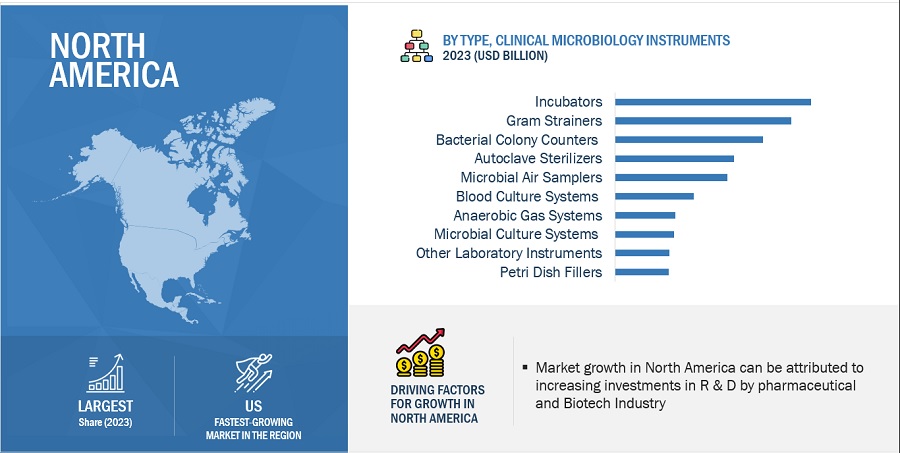
To know about the assumptions considered for the study, download the pdf brochure
Prominent players in the Clinical Microbiology market include BioMérieux (France), Danaher Corporation (US), Becton, Dickinson, and Company (BD) (US), Abbott (US), F. Hoffmann-La Roche Ltd. (Switzerland), Thermo Fisher Scientific Inc. (US), Agilent Technologies, Inc. (US), Bruker (US), Hologic, Inc. (US), Merck KGaA(Germany), Bio-Rad Laboratories, Inc.(US), QIAGEN(Netherlands), Shimadzu Corporation(Japan), Neogen Corporation (US), Siemens Healthineers AG (Germany). Emerging players including, Hardy Diagnostics (US), EMSL Analytical, Inc. (US), Lofilchem S.R.L (Italy), TCS Biosciences (UK), Cole-Parmer Instrument Company, LLC (US), Memmert GmbH + Co.KG (Germany), Vacutest Kima S.r.l (Germany), Rapid Micro Biosystems, Inc. (US), Biotechnology Solutions TX, LLC (US), and Arrow Diagnostics Srl (Italy).
Scope of the Clinical Microbiology Industry:
|
Report Metric |
Details |
|
Market Revenue in 2024 |
$5.0 billion |
|
Projected Revenue by 2029 |
$6.9 billion |
|
Revenue Rate |
Poised to Grow at a CAGR of 6.5% |
|
Market Driver |
Advancements in Technology for Disease Diagnostics |
|
Market Opportunity |
Enhancing Healthcare Infrastructure in Emerging Countries |
The study categorizes the clinical microbiology market to forecast revenue and analyze trends in each of the following submarkets:
By Type
- Instruments
-
Laboratory instruments
- Incubators
- Gram Strainers
- Bacterial Colony Counters
- Autoclave sterilizers
- Microbial Air samplers
- Blood Culture Systems
- Anaerobic culture system
- Microbial Culture System
- Petri dish fillers
- Other laboratory Instruments
-
Microbiology Analyzers
- Molecular Diagnostics Instrument
- Mass Spectrometers
- Microscopes
-
Reagents and Consumables
- Pathogen Specific Kits
- General Reagents
- Culture Media and Sera
By Disease
- Respiratory Disease
- Bloodstream Infections
- Gastrointestinal Disease
- Sexually Transmitted Disease
- Urinary Tract Infections
- Periodontal Disease
- Other Disease
By Application
- Clinical Disease Diagnosis
- Food And Beverage Testing
- Pharma And Biopharma Testing
- Environmental Testing
- Chemical And Material Manufacturing
- Oil And Gas Testing
By End User
- Hospitals and Diagnostics Centers
- Contract Testing Laboratories
- Research And Academic Institutes
By Region
-
North America
- US
- Canada
-
Europe
- Germany
- UK
- Italy
- Spain
- France
- RoE
-
Asia Pacific
- Japan
- China
- India
- South Korea
- Australia
- RoAPAC
-
Latin America
- Brazil
- Mexico
- Rest of Latin America
-
Middle East and Africa
- GCC Countries
- Rest of Middle East and Africa
Recent Developments of the Clinical Microbiology Industry:
- In January 2024, BioMérieux(France) acquired LUMED(Canada), a Canadian software company, to enhance antimicrobial stewardship and infection control programs.
- In February 2024, Becton, Dickinson and Company (US) partnered with Camtech Health (Singapore) to advance cervical cancer screening by offering the option for women in Singapore to self-collect a sample in the privacy of their own home.
- In December 2023, F. Hoffmann-La Roche Ltd. (Switzerland) formed a definitive agreement to acquire LumiraDx's Point of Care technology, which integrates multiple diagnostic modalities onto a single platform. This strategic move underscores Roche's commitment to advancing point-of-care diagnostics and expanding its portfolio to meet evolving healthcare needs.
Frequently Asked Questions (FAQ):
What is the projected market revenue value of the global clinical microbiology market?
The global clinical microbiology market boasts a total revenue value of $6.9 billion by 2029.
What is the estimated growth rate (CAGR) of the global clinical microbiology market?
The global clinical microbiology market has an estimated compound annual growth rate (CAGR) of 6.5% and a revenue size in the region of $5.0 billion in 2024. .
To speak to our analyst for a discussion on the above findings, click Speak to Analyst
This research study involved the extensive use of both primary and secondary sources. It involved the study of various factors affecting the industry to identify the segmentation types, industry trends, key players, the competitive landscape of market players, and key market dynamics such as drivers, opportunities, challenges, restraints, and key player strategies.
Secondary Research
This research study involved the wide use of secondary sources, directories, databases such as Dun & Bradstreet, Bloomberg Businessweek, and Factiva, white papers, and companies’ house documents. Secondary research was undertaken to identify and collect information for this extensive, technical, market-oriented, and commercial study of the Clinical Microbiology Market. It was also used to obtain important information about the top players, market classification, and segmentation according to industry trends to the bottom-most level, geographic markets, and key developments related to the market. A database of the key industry leaders was also prepared using secondary research.
Primary Research
In the primary research process, various supply side and demand side sources were interviewed to obtain qualitative and quantitative information for this report. Primary sources from the supply side included industry experts such as CEOs, vice presidents, marketing and sales directors, technology & innovation directors, engineers, and related key executives from various companies and organizations operating in the Clinical Microbiology Market. Primary sources from the demand side included researchers, lab technicians, reagent suppliers, purchase managers etc, and stakeholders in corporate & government bodies.
A breakdown of the primary respondents is provided below:
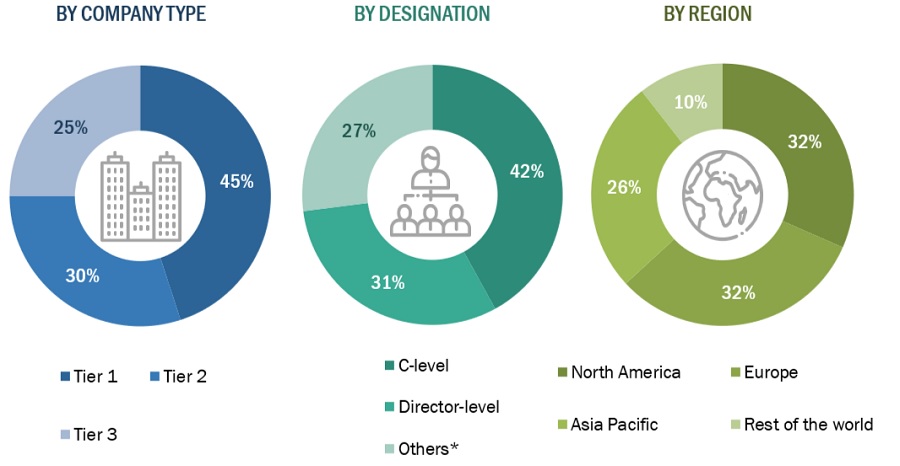
*Others include sales managers, marketing managers, and product managers.
Note: Tiers are defined based on a company’s total revenue, as of 2020: Tier 1 = >USD 1 billion, Tier 2 = USD 500 million to USD 1 billion, and Tier 3 = <USD 500 million.
To know about the assumptions considered for the study, download the pdf brochure
Market Size Estimation
The total size of the Clinical Microbiology Market was arrived at after data triangulation through the two approaches mentioned below. After the completion of each approach, the weighted average of these approaches was taken based on the level of assumptions used in each approach.
Data Triangulation
The size of the Clinical Microbiology Market was estimated through segmental extrapolation using the bottom-up approach. The methodology used is as given below:
- Shares of leading players in the Clinical Microbiology Market were gathered from secondary sources to the extent available. In some instances, shares of clinical microbiology have been ascertained after a detailed analysis of various parameters, including Service portfolios, market positioning, selling price, and geographic reach & strength.
- Individual shares or revenue estimates were validated through interviews with experts.
- The total revenue in the clinical microbiology was determined by extrapolating the Market share data of major companies.
Global clinical microbiology market Size: Top-Down Approach
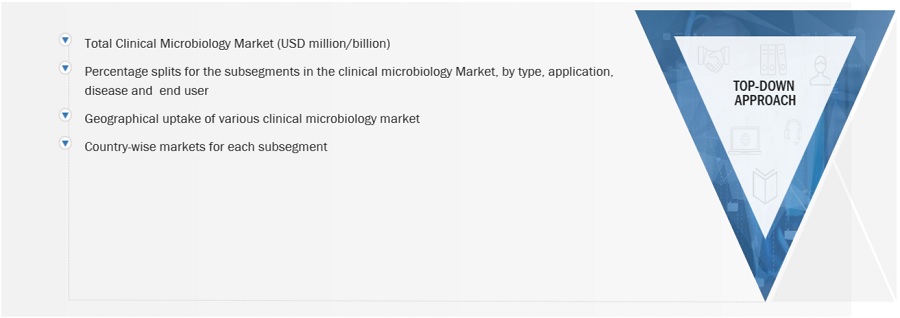
To know about the assumptions considered for the study, Request for Free Sample Report
Market Definition
Microbiology testing (also known as microbial testing) is a laboratory procedure, which is used to identify microbial contamination in target samples. This procedure is used for microbial identification during manufacturing processes, disease diagnosis & management, and pollution control & monitoring. Microbial testing is used in clinical diagnostics for the identification and characterization of disease-causing microorganisms. Microbial assessment is of the utmost importance in diagnosis of infectious diseases to plan the treatment.
Key Stakeholders
- Manufacturers of Microbiology testing/Clinical Microbiology Products
- Healthcare Service Providers
- Manufacturers of Pharmaceutical Products
- Clinical Research Organizations (CROs)
- Clinical Testing Laboratories
- Food and Beverages Manufacturing Companies
- Manufacturers of Petrochemical and Biofuel Products
- Oil & Gas Production and Distribution Companies
- Gas Operators, Distributors, and Regulators
- Environmental Monitoring Committees
- Manufacturers of Environmental Monitoring Products
- National & Regional Pollution Control Boards and Organizations
- Research Laboratories and Academic Institutes
- Market Research and Consulting Firm
Objectives of the Study
- To define, describe, and forecast the global microbiology testing market on the basis of application.
- To define, describe, and forecast the global clinical microbiology market on the basis of product, disease area, end user, and region.
- To provide detailed information regarding the major factors influencing the growth of the market (drivers, restraints, growth opportunities, and challenges)
- To strategically analyze micromarkets1 with respect to individual growth trends, future prospects, and contributions to the overall market
- To analyze the opportunities in the market for key stakeholders and provide details of the competitive landscape for major market leaders
- To forecast the size of the market segments with respect to four main regions: North America (the US and Canada), Europe (Germany, the UK, France, Italy, Spain, and Rest of Europe), Asia Pacific (Japan, China, India, Australia, South Korea and Rest of Asia Pacific), the Latin America (Brazil, Mexico and Rest of Latin America) and Middle East & Africa.
- To profile key market players and comprehensively analyze their market shares and core competencies2
- To track and analyze competitive developments such as mergers and acquisitions; new product developments; partnerships, agreements, and collaborations; and expansions in the global clinical microbiology market
Available Customizations
With the given market data, MarketsandMarkets offers customizations as per your company’s specific needs. The following customization options are available for the report:
Company Information
- Detailed analysis and profiling of additional market players (up to 5)
Geographic Analysis
- Further breakdown of the Rest of Europe Clinical Microbiology Market into Denmark, Norway, and others
- Further breakdown of the Rest of Asia Pacific Clinical Microbiology Market into Vietnam, New Zealand, and others



 Generating Response ...
Generating Response ...







Growth opportunities and latent adjacency in Clinical Microbiology Market